
Have you ever found yourself in a beef slump? Consistently using the same cut and wondered which other cuts might take your dish from good to unforgettable? Selecting the right cut of beef is not just about taste; it’s about understanding the unique characteristics of each cut and how to use them to your advantage in the kitchen. This guide is tailored for chefs who are looking to deepen their knowledge of beef cuts, discover some lesser-known cuts, and pick up practical tips for cooking each type.
Make sure to jump down to the bottom for our FAQ and glossary!
Chuck


Location: At the steer’s forefront, encompassing the shoulder and neck. Its versatility and affordability make it a staple in many kitchens.
Sub-primal Cuts: This includes neck, shoulders, top blade, bottom blade, ground beef, chuck steak, and chuck filet.
Chef’s Tips:
Slow and Low: Shoulder and neck thrive in a low-temp conventional oven.
Blade Cuts: Direct grilling brings out their best.
Flat Iron
Cut from the shoulder area, specifically the top blade of the chuck.
Pros: Versatility in cooking methods. Value cut with high-quality eating experience
Cons: Grain Awareness – Be mindful of the grain when slicing this steak to ensure maximum tenderness. Availability – Not always readily available as more traditional cuts
Best Uses: Flat Iron takes well to marinades. Its tenderness and flavor profile make it a fantastic option for slicing thinly against the grain for sandwiches.
Teres Major
Located in the shoulder area. One of the most tender cuts of beef after the tenderloin.
Pros: Extremely tender. Comparable to more expensive cuts like the tenderloin, making it a great value. Rich tenderloin-like flavor.
Cons: Availability – Not as widely know or available. Preparation – Requires careful trimming for optimal tenderness.
Best Uses: Great grilled or pan-seared. Can be cut into medallions and cooked quickly.
Rib

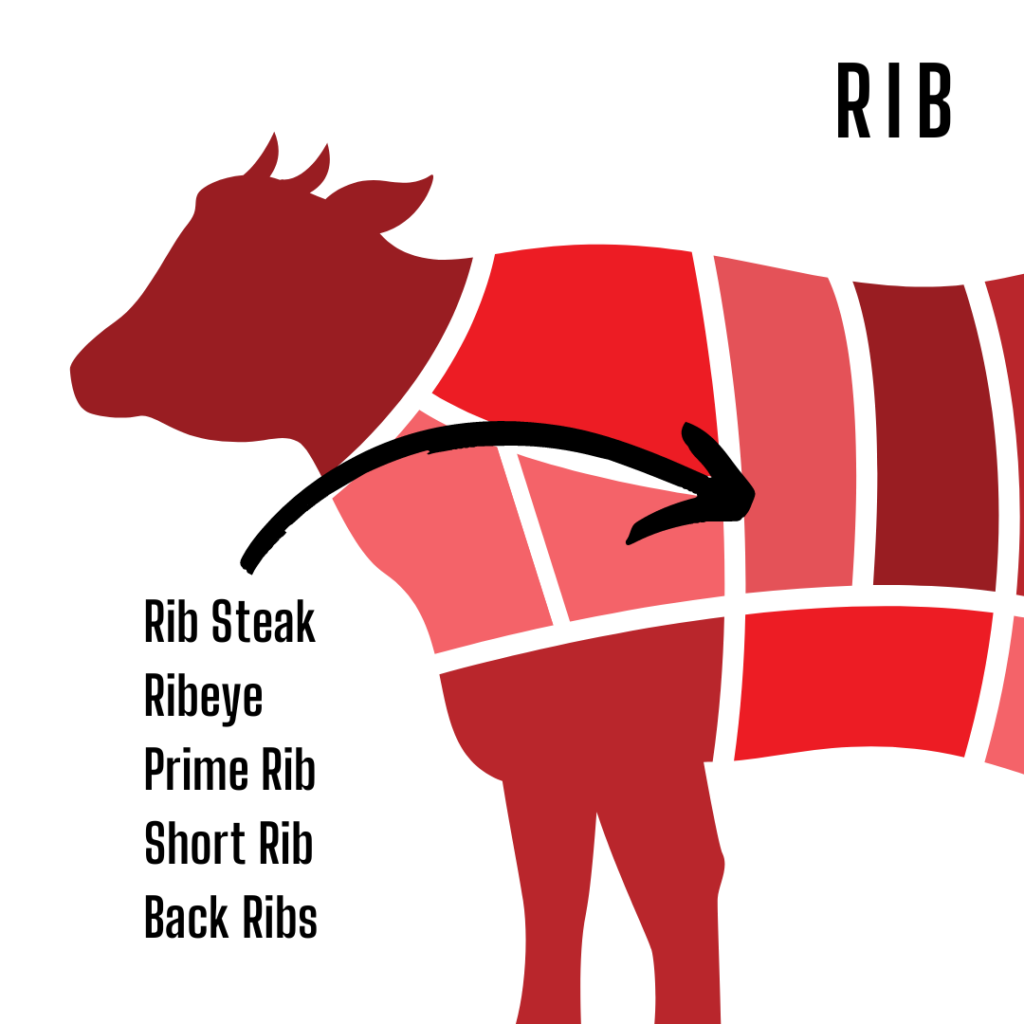
Location: The rib primal includes meat from the cow’s ribs and backbone, renowned for its fatty marbling and tenderness.
Sub-primal Cuts: Look for rib steak, ribeye, prime rib, short rib, and back ribs.
Chef’s Tips:
Prime Rib Excellence: High temp, short time in an oven or direct heat smoker.
Ribeye: Charcoal-grilled to enhance flavor.
Back Ribs: Low and slow in an offset smoker for tender results.
Short Ribs: Ideal for braising and Korean BBQ styles; a hit when grilled.
The Ribeye
Cut from the rib section. High in marbling and fat.
Pros: Rich, beefy flavor. Tender and juicy texture.
Cons: Higher fat content may not suit all dietary preferences. Requires careful cooking to avoid flare-ups.
Best Uses: Perfect for grilling and broiling. Minimal seasoning needed to showcase its natural flavor.
Short Rib
Cut from the rib area. Contains a portion of the rib bone.
Pros: Rich and full of flavor. Tender when slow-cooked.
Cons: Requires long cooking time. Can be fatty.
Best Uses: Perfect for braising and barbecue. Great in stews and Korean dishes.
The Prime Rib Roast
Cut from the rib section of the cow, encompassing from the 6th to the 12th rib.
Pros: Naturally tender cut. The marbling and fat contribute to a deep, beefy flavor.
Cons: Requires a longer cooking time, needing careful attention to achieve the perfect doneness. Prime Rib can be one of the more expensive beef cuts.
Best Uses: Slow-roasting allows the fat to render and the meat to cook evenly, resulting in a juicy, flavorful roast. Traditionally served with au jus (a light beef gravy) and horseradish sauce to complement its rich flavors.
Loin
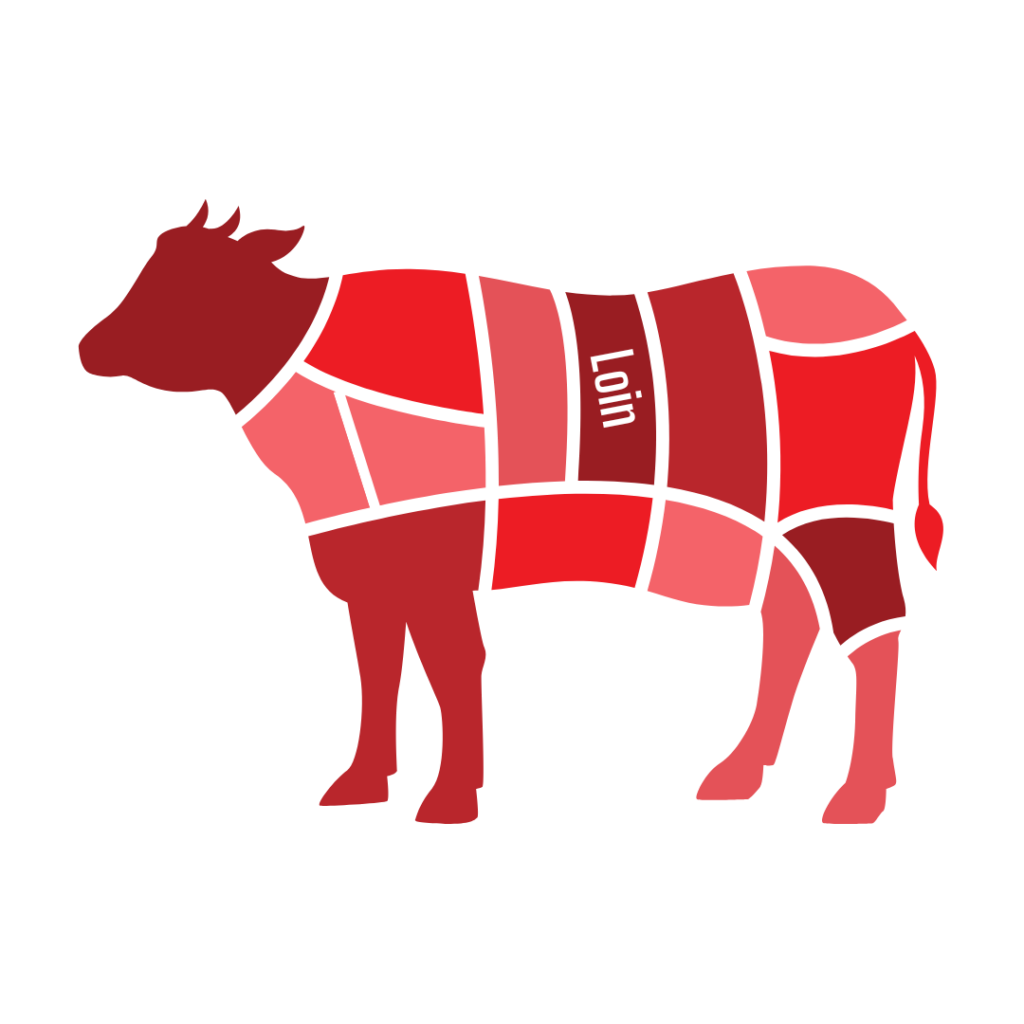
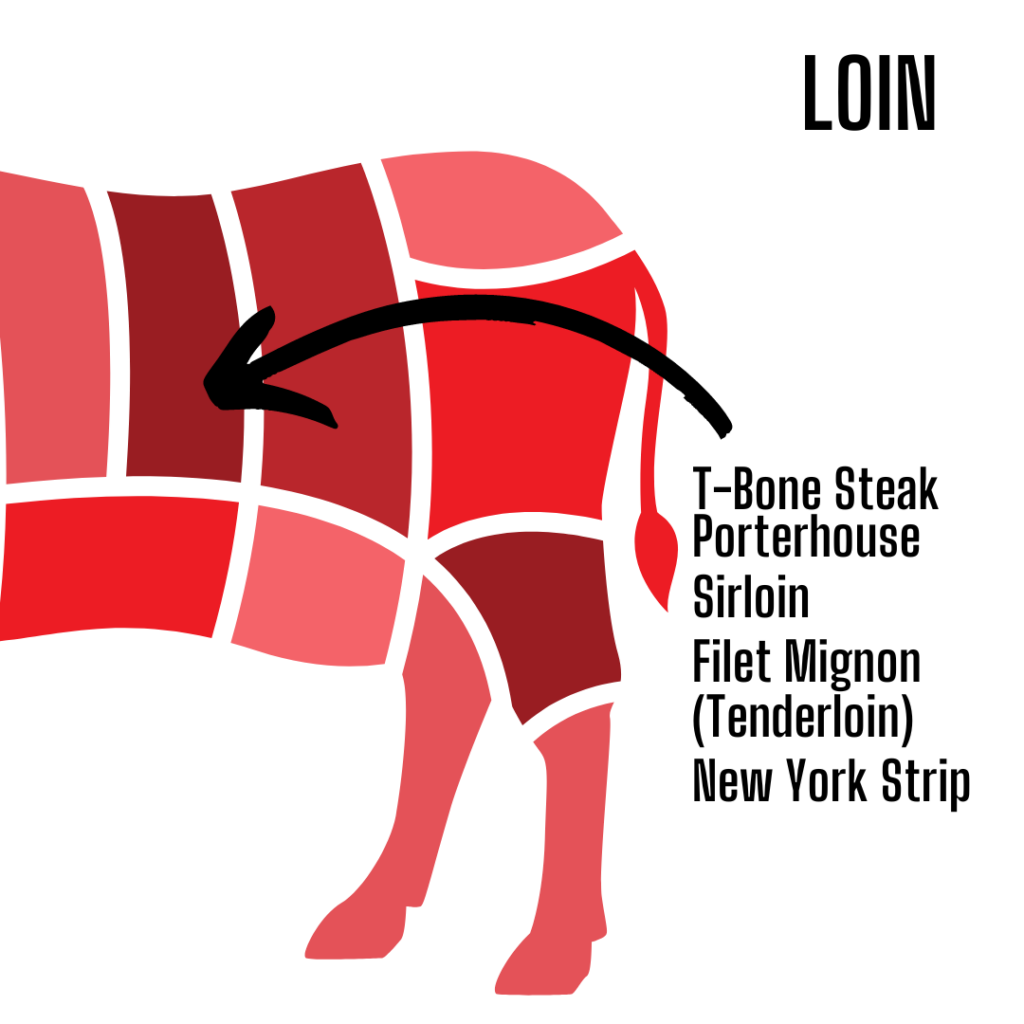
Location: Located behind the ribs, the loin offers the most tender cuts, such as sirloin and short loin.
Sub-primal Cuts: Includes T-bone, club steak, filet mignon (tenderloin), New York strip, and more.
Chef’s Tips:
High-Value Steaks: Medium-rare via open flame or direct heat grill.
Everyday Elegance: Sirloin and New York strip offer versatile options for daily menus.
The Tenderloin
Located along the spine. Least fatty cut.
Pros: Extremely tender. Low in fat.
Cons: Less flavor due to low fat content. Higher cost.
Best Uses: Perfect for filet mignon. Quick cooking methods like searing or grilling are ideal.
The Porterhouse
A large portion of tenderloin on one side of the T-shaped bone and a generous portion of strip steak on the other.
Pros: Dual experience of tender and flavorful meat. Generous size – ideal for sharing.
Cons: Requires attention while cooking to ensure both the tenderloin and strip are cooked to perfection. Higher price point.
Best Uses: Best grilled or broiled. Excellent for a premium steak experience.
The Strip
Pros: Versatility in cooking methods: grilling, broiling, pan-searing. Rich beefy taste, enhanced by marbling.
Cons: Marbling and tenderness can vary depending on the grade of meat. Can be pricier than some other cuts due to its popularity and demand.
Best Uses: High heat cooking methods bring out its flavor and create a delicious crust. Can be sliced thinly against the grain for use in salads or sandwiches, offering a tender bite.
The Sirloin
Located between the loin and the round. Lean yet tender.
Pros: Versatility in cooking methods: grilling, broiling, pan-frying. Balanced flavor suitable for a range of dishes.
Cons: Less marbling compared to other cuts. Can become tough if overcooked.
Best Uses: Ideal for steaks, stir-fries, and kebabs. Marinating can enhance flavor and tenderness.
The Coulotte
Also known as the top sirloin cap, rump cap, or picanha. Features a moderate to high degree of marbling.
Pros: Value – A high-quality eating experience often at a lower cost. Flavorful – The marbling and fat cap contribute to a rich beefy flavor
Cons: Preparation – Proper trimming and scoring of the fat cap are necessary for optimal cooking and presentation. Variability in Thickness
Best Uses: Roasting whole with the fat cap scored can create a beautifully crispy exterior while keeping the inside juicy. Particularly popular in Brazilian cuisine for churrasco, it’s ideal for grilling
Round
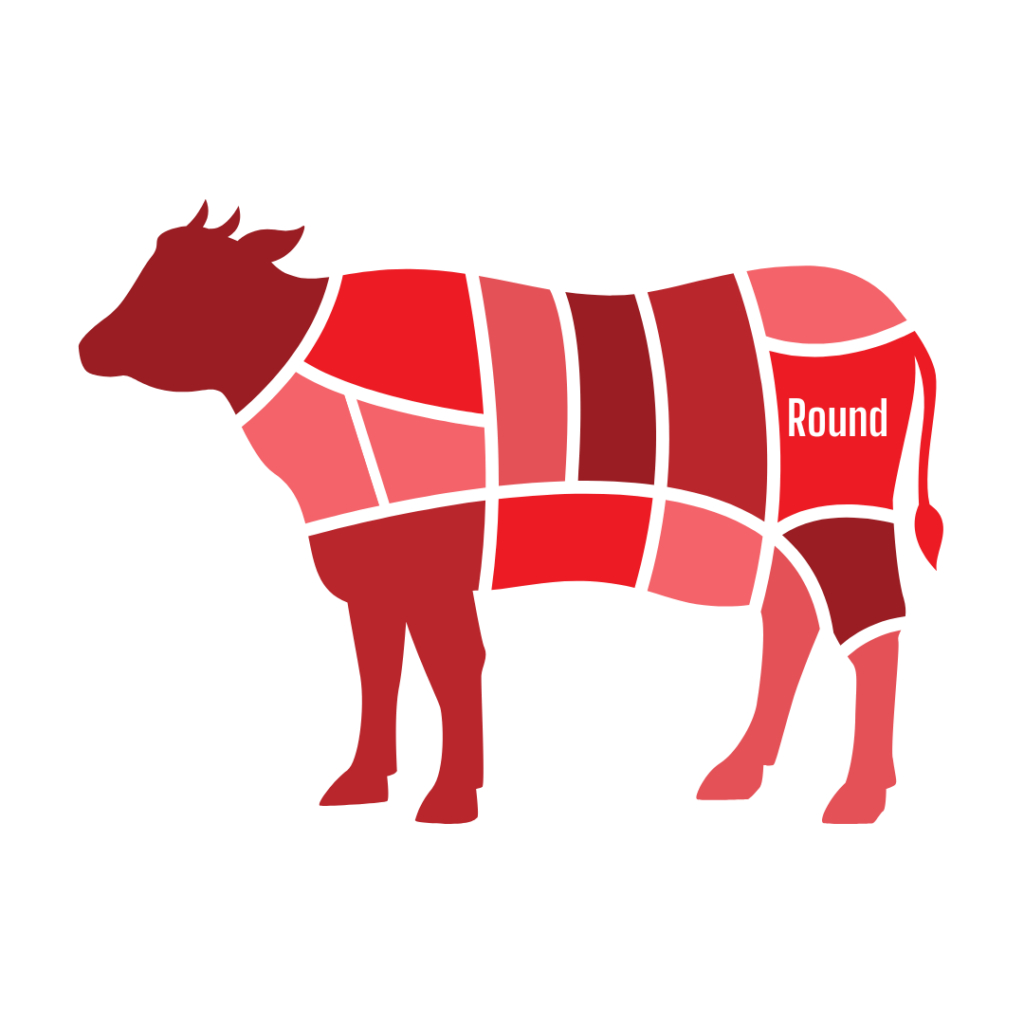
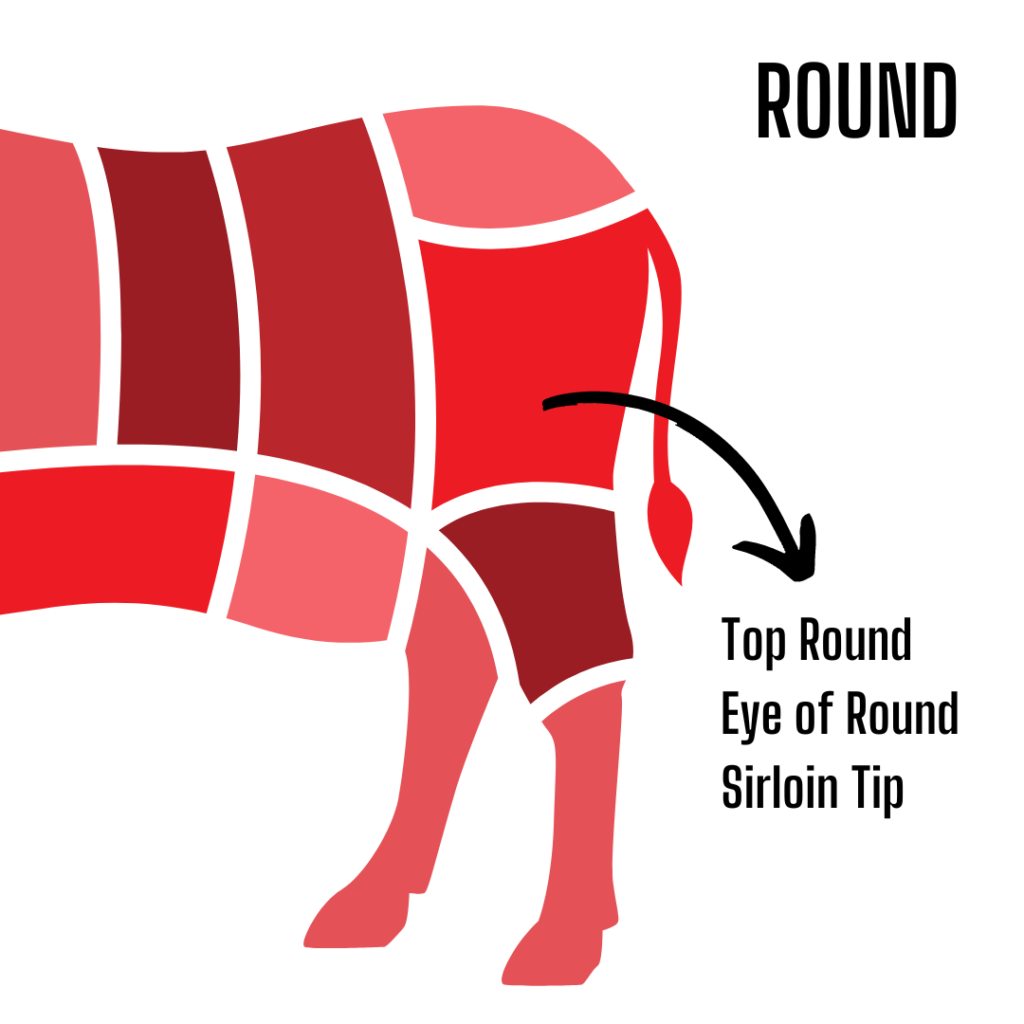
Location: Near the cow’s hind legs, the round is lean and tougher, making it a budget-friendly option.
Sub-primal Cuts: Explore top round, eye of round, sirloin tip and others.
Chef’s Tips:
Oven Mastery: Embrace low and slow techniques for tender outcomes.
Eye of Round
It is one of the leanest beef cuts, with minimal fat and marbling.
Pros: Lower in fat. More affordable compared to premium cuts
Cons: Requires careful cooking to avoid toughness. Less flavorful than fattier cuts.
Best Uses: Great for roasting, slow cooking. Ideal for deli meats especially when cooked medium rare and chilled.
Sirloin Tip
Cut from the muscle group that helps support the hip and leg, making it leaner.
Pros: More affordable than prime cuts, offering good value. Can be used in a variety of dishes, from roasts to stews.
Cons: Requires careful cooking to avoid toughness. Benefits from marinating or slow cooking methods to enhance tenderness.
Best Uses: Ideal for kabobs or steak tips when marinated. Perfect for stews and slow-cooked dishes where it can become tender over time.
Flank
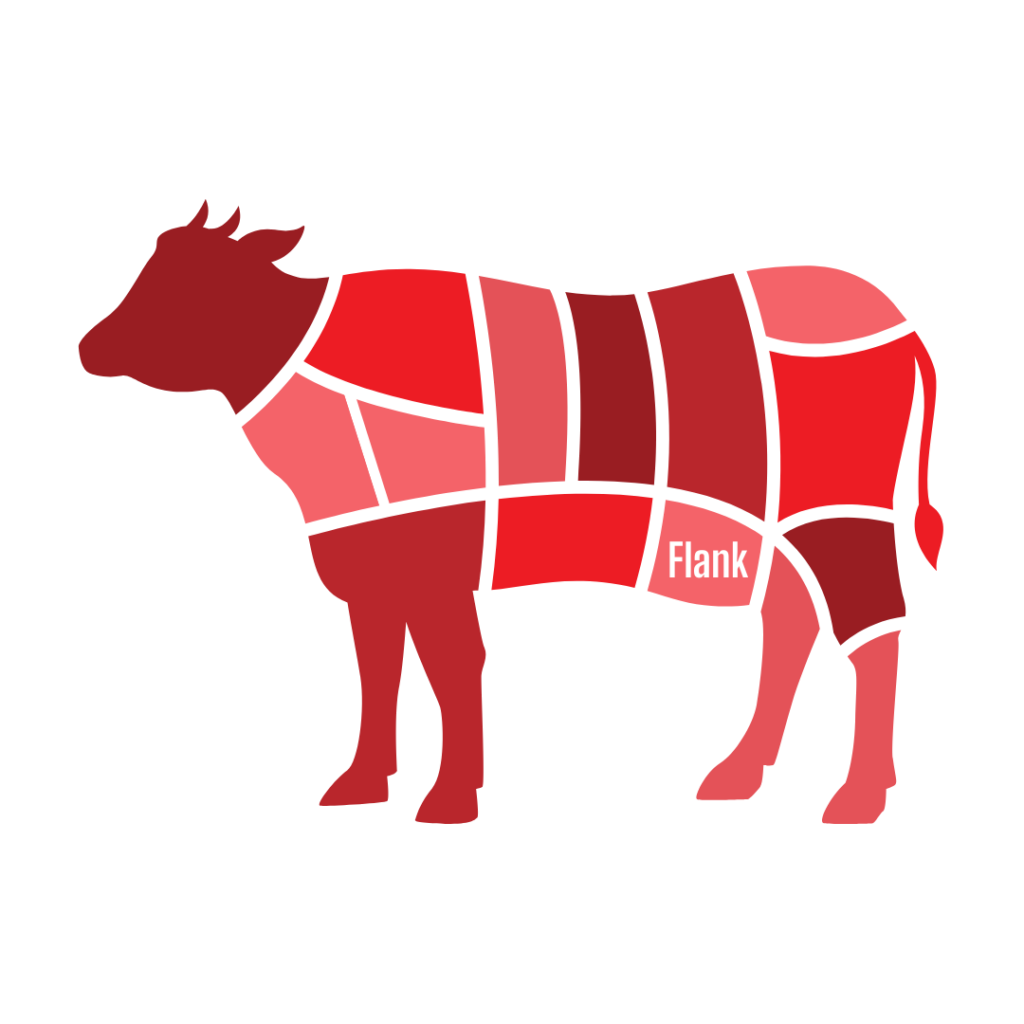
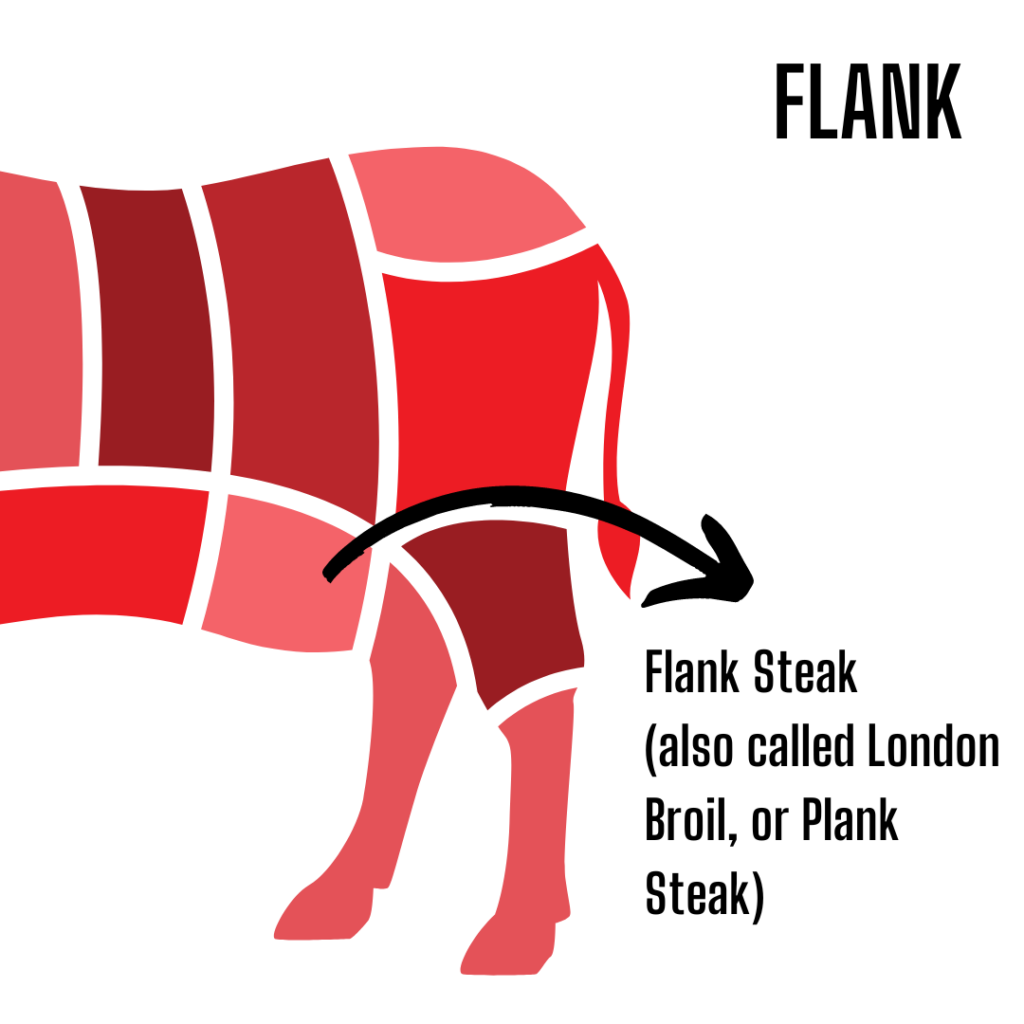
Location: Below the loin, flank is flavorful yet tough, rising in popularity and price with the lean meat trend. It’s all about the marinade.
Sub-primal Cuts: Flank steak (also called London broil, or plank steak)
Chef’s Tips:
Marinate, Then Grill: Overnight soaking followed by a sear on an open flame or direct heat grill for optimal flavor.
Flank Steak
Cut from the abdomen muscles. Long and flat.
Pros: Rich in beef flavor. Absorbs marinades well.
Cons: Can be tough and chewy. Requires specific cutting technique.
Best Uses: Best when marinated and grilled. Ideal for fajitas, stir-fries.
Short Plate
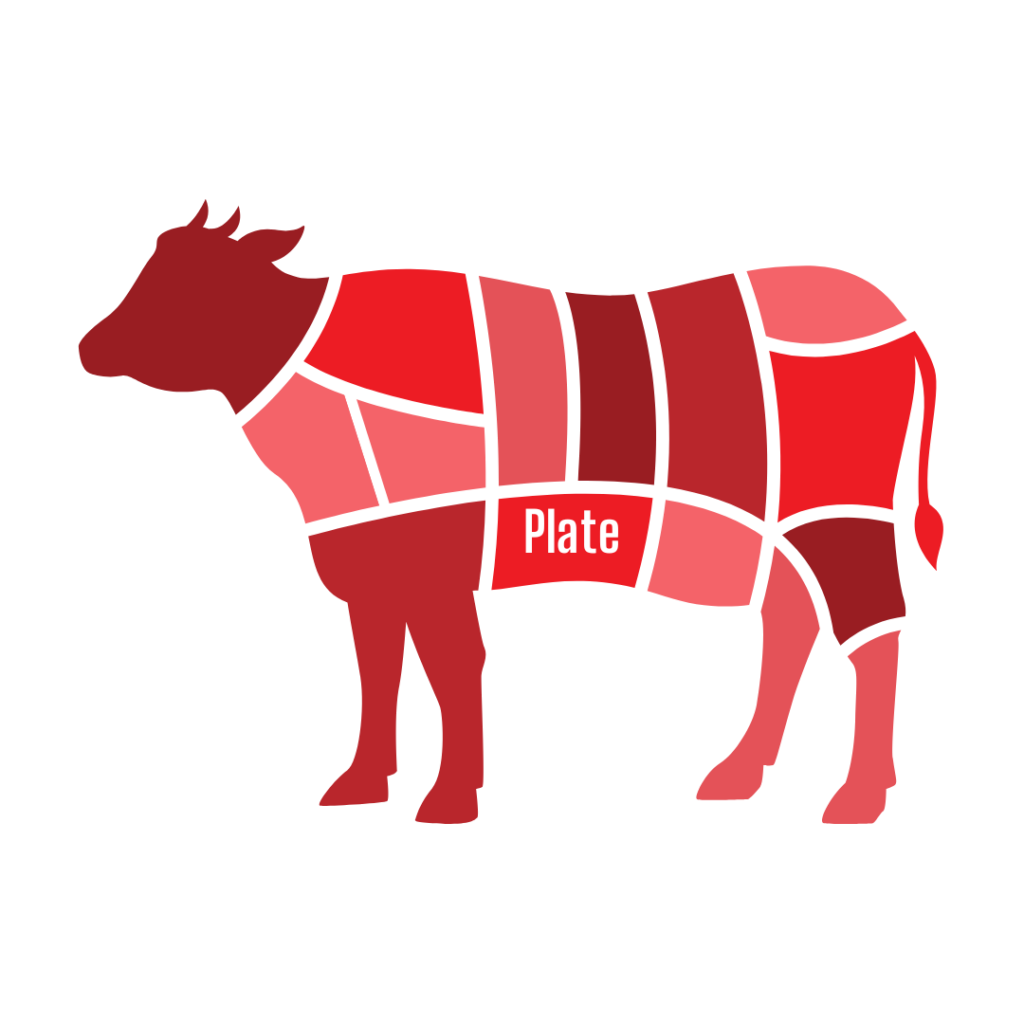
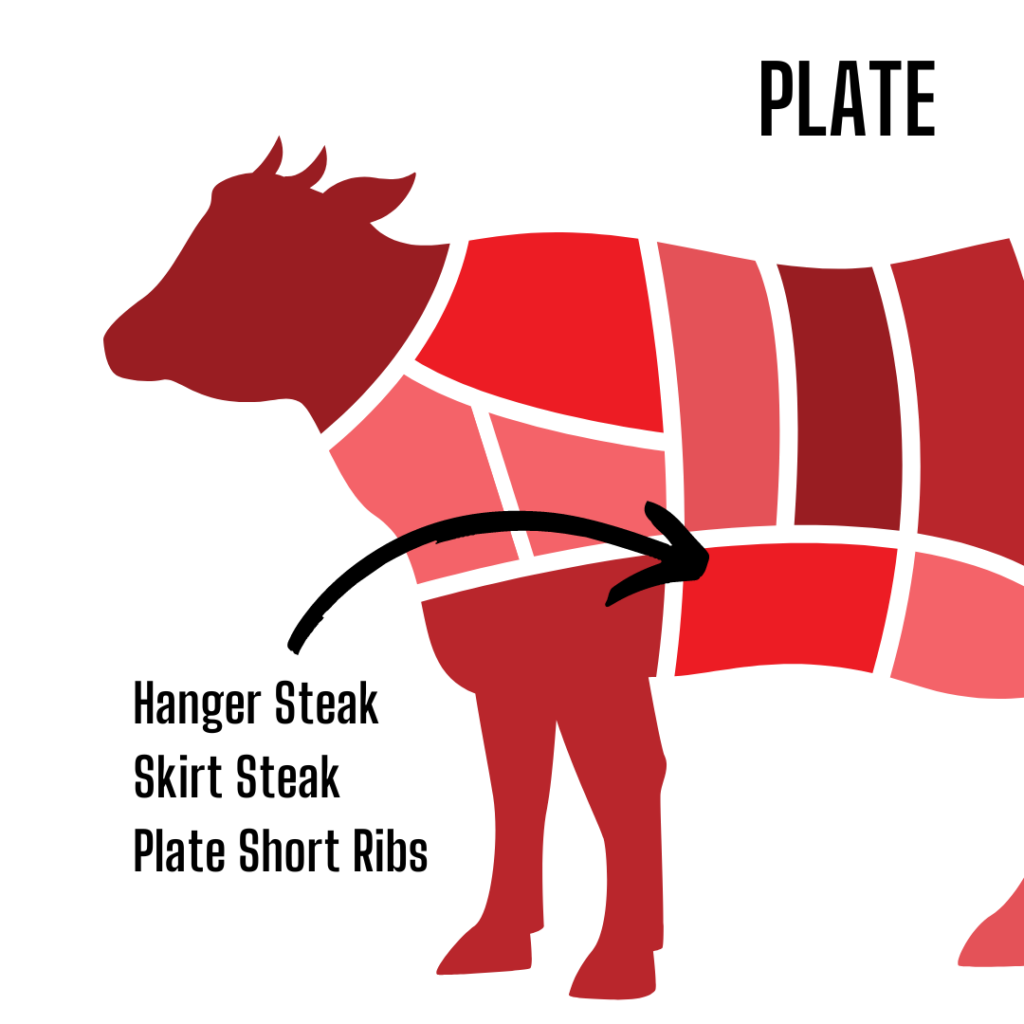
Location: Below the ribs, a haven for hanger and skirt steaks.
Sub-primal Cuts: Hanger steak, skirt steak, plate short ribs
Chef’s Tips:
Hanger Steak: Medium-rare on a grill for tenderness.
Hanger Steak
Also known as “butcher’s steak” or “onglet” in French cuisine. Located between the rib and the loin, attached to the diaphragm.
Pros: Flavorful. Tender when cooked properly.
Cons: Requires careful preparation to remove inedible membrane and silver skin for optimal enjoyment. Each animal yields only one Hanger Steak, making it less available than other cuts.
Best Uses: Often featured in French bistro cuisine, it’s ideal for dishes like steak frites, showcasing its robust flavor. Its texture and flavor profile make it an excellent candidate for marinating.
Brisket
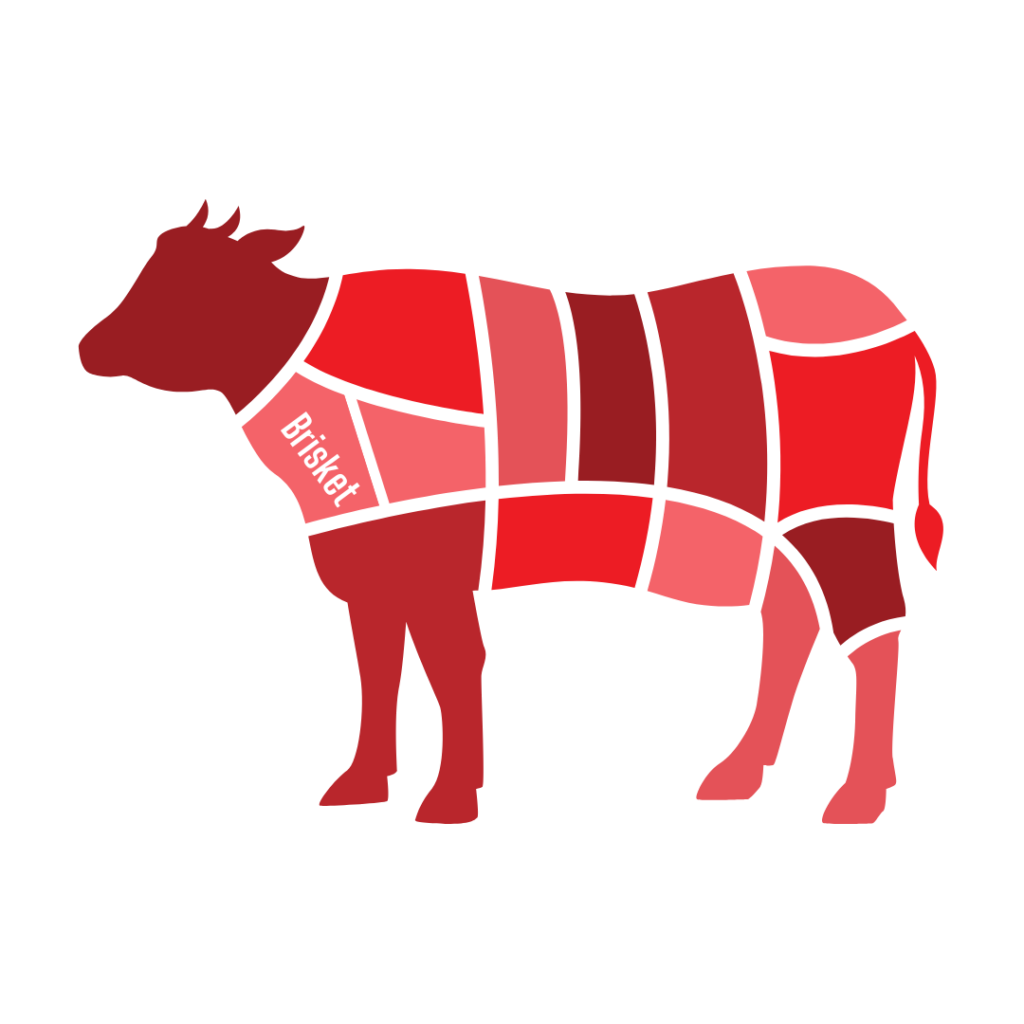

Location: Cow’s breast or lower chest, demanding patience and slow cooking.
Sub-primal Cuts: Brisket point and plate.
Chef’s Tips:
Indirect Heat Smoker: Ideal for achieving tender and flavorful brisket.
Pro Insight: Always monitor meat temperature to ensure perfection, especially for those long cooks like brisket.
Brisket
High connective tissue content.
Pros: Deep, rich flavor. Ideal for slow cooking methods.
Cons: Requires long cooking time. Can be tough if rushed.
Best Uses: Excellent for smoking, braising, and slow roasting. Perfect for barbecue and corned beef.
Shank

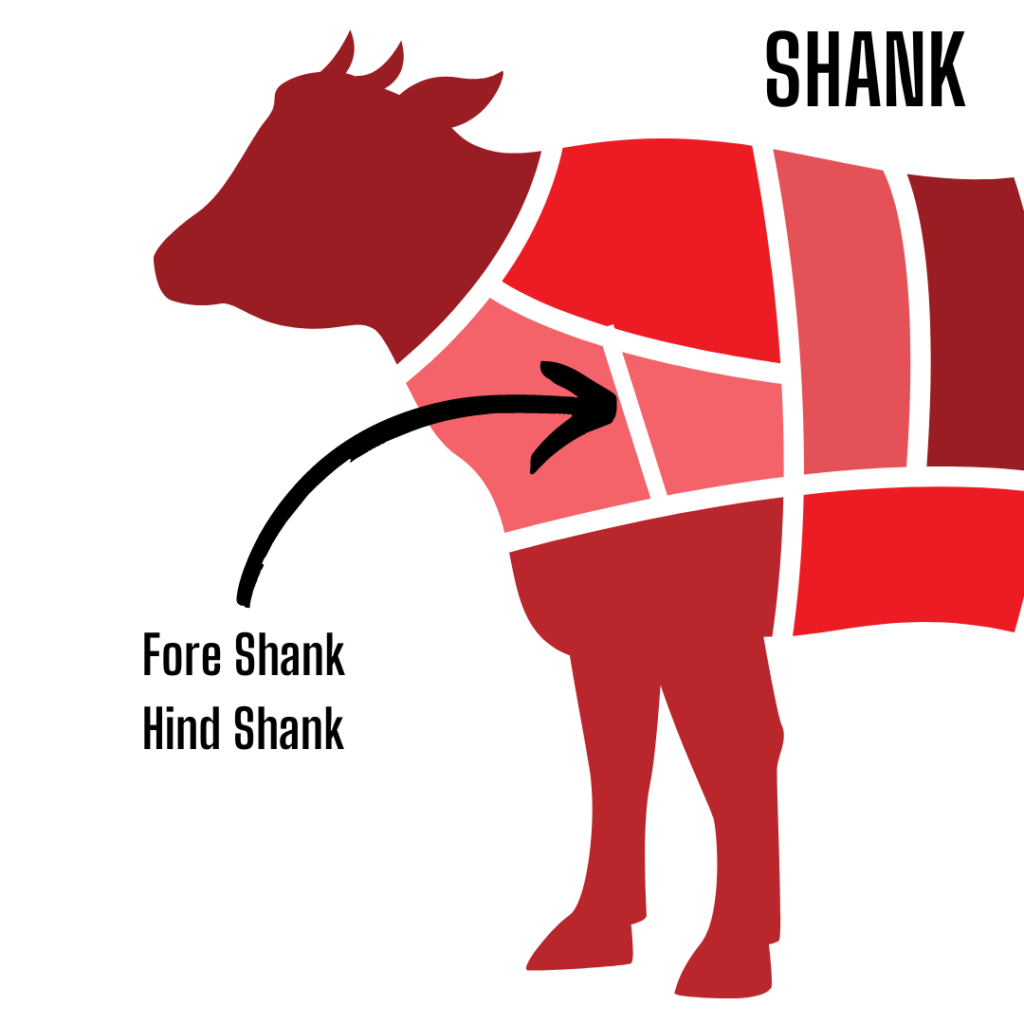
Location: Located at the cow’s forearm, shank is the toughest cut but offers deep flavor for stocks and stews.
Sub-primal Cuts: Fore shank, hind shank. Ideal for Osso Buco.
Chef’s Tips:
Patience Pays Off: Long, low-temperature cooking in crockpots or ovens brings out the best.
Fore Shank
Cut from the leg portion. High in connective tissue.
Pros: Flavorful and rich. Ideal for slow cooking.
Cons: Can be very tough if not cooked properly. Limited cooking method suitability.
Best Uses: Excellent for osso buco, stews. Slow cooking enhances flavor and tenderness.
Choosing the right cut of beef can transform your dish into a memorable experience for your diners. Remember, each cut has its unique properties and optimal cooking methods. If you’re looking for advice on selecting and preparing these cuts, our team of beef experts is here to assist you. Don’t hesitate to reach out with your questions and let us help you make the most of every cut.

Why is my meat not red in the package?
When beef is packaged, particularly in vacuum-sealed packaging, it might not appear red until it is opened due to the lack of oxygen inside the package. Beef muscle contains a protein called myoglobin, which is responsible for transporting oxygen within the muscle tissues. The color of myoglobin changes depending on its exposure to oxygen.
In vacuum-sealed packages, there’s a significant reduction in oxygen. Inside these packages, myoglobin takes on a darker color, ranging from purple to brown, because it’s in a deoxygenated state known as deoxymyoglobin. This is why beef might not look red when it’s still sealed in its packaging.
Once the package is opened, the myoglobin in the beef is exposed to oxygen again. This exposure converts the deoxymyoglobin to oxymyoglobin, which has a bright red color commonly associated with fresh beef. This process is known as “blooming” and can take a few minutes after the package is opened.
It’s important to note that the initial darker color of vacuum-sealed beef does not indicate spoilage or poor quality; it’s a natural result of the packaging process designed to preserve the freshness and extend the shelf life of the beef by reducing its exposure to oxygen.
What is the difference between a porterhouse and a T-bone?
The difference between a Porterhouse and a T-bone steak boils down to the size of the tenderloin portion and where they are cut from the short loin.
Tenderloin Size: Porterhouse steaks have a larger tenderloin section (at least 1.25 inches wide) compared to T-bones, which have a smaller tenderloin (at least 0.5 inches but less than 1.25 inches wide).
Location on the Short Loin: Porterhouses are cut from the rear end, yielding more tenderloin, while T-bones come from the middle, with less tenderloin.
Steak Experience: Porterhouses offer a more premium experience with more tenderloin, appealing to those who prefer this cut. T-bones provide a balanced taste of both the strip and tenderloin but with less emphasis on the tenderloin.
What is the difference between a bone-in, split bone & frenched ribeye?
The difference between bone-in, split bone, and frenched ribeye steaks mainly lies in the treatment and presentation of the bone within each cut:
Bone-In Ribeye: This is the traditional ribeye steak that includes a portion of the rib bone. The bone is left intact, contributing to the steak’s flavor and moisture during cooking. It’s known for its rich marbling and deep flavor.
Split Bone Ribeye: In this variation, the rib bone is partially split or cut through at intervals. This can help the steak cook more evenly and makes it easier to carve or serve, while still retaining the flavor benefits of cooking with the bone.
Frenched Ribeye: For a frenched ribeye, the meat is cut away from the end of the rib bone, exposing it and giving the steak a more elegant presentation. This style doesn’t significantly affect the flavor but is often preferred for its sophisticated appearance, especially in fine dining settings.
Each style offers a different experience, primarily in terms of presentation and ease of eating, with the bone-in and split bone options also contributing slightly to the flavor and juiciness of the meat due to their bone content.
So then what is a tomahawk ribeye?
A Tomahawk Ribeye is a distinctive cut of beef ribeye that includes a long, frenched rib bone extending from the meat. Its appearance resembles a tomahawk axe, which is where the cut gets its name. This cut is essentially a bone-in ribeye steak with the entire rib bone left intact and extended, often measuring up to 12 inches or more in length. The meat itself is the same richly marbled, tender ribeye that is prized for its depth of flavor and tenderness.
What is a 107 rib?
A 107 rib, often referred to in the meat industry, is a specific cut of beef rib that includes the rib primal with the ribeye muscle, a portion of the backstrap, and the entire rib bone. It’s a traditional, wholesale cut that hasn’t been trimmed down to the more retail-friendly or consumer-recognized ribeye steaks or roasts yet. The “107” designation is a numerical code used by the meat industry to identify this particular cut’s specifications and preparation style.
This cut includes the first five to seven ribs of the animal, extending from the chuck to the loin section. The 107 rib is particularly valued for its marbling and flavor, making it a favorite starting point for producing high-quality ribeye steaks or prime rib roasts after further processing and trimming. The bone-in nature of this cut contributes to the meat’s flavor during cooking, making it a sought-after choice for roasting whole as a standing rib roast, where it can serve as a dramatic and flavorful centerpiece for special occasions.
Why is it beneficial to keep the cap on ribeye for dry-aging?
The outer layer of meat and fat, including the cap, acts as a barrier during the dry-aging process. It helps protect the inner, more valuable part of the ribeye from overexposure to air, which can lead to excessive drying or spoilage. As the beef dry ages, moisture evaporates from the muscle, concentrating its flavors and improving texture. The cap helps ensure that this process happens slowly and evenly, enhancing the steak’s taste and tenderness without losing too much volume to desiccation.

Aging: The process of letting beef rest under controlled conditions to enhance its tenderness and flavor. There are two types: dry-aging and wet-aging.
Dry-Aging: A process of aging beef in a controlled, open-air environment to intensify its flavor and tenderize the meat.
Wet-Aging: Aging beef in a vacuum-sealed bag to retain moisture, making the meat more tender over time.
Marbling: Intramuscular fat that appears as white flecks within the muscle. Higher marbling usually indicates more flavorful and tender meat.
Grain-Fed: Cattle that have been fed primarily with grains like corn, leading to beef with higher fat content and marbling.
Grass-Fed: Beef from cattle that have been raised on grass diets. This meat is typically leaner and has a different flavor profile compared to grain-fed beef.
Prime Cut: The highest grade of beef with abundant marbling, indicating top-quality tenderness, juiciness, and flavor.
Choice Cut: High-quality beef with less marbling than prime cuts. Choice cuts are still tender and flavorful.
Select Cut: A grade of beef that is generally leaner with less marbling. Select cuts can be less tender and flavorful compared to higher grades.

